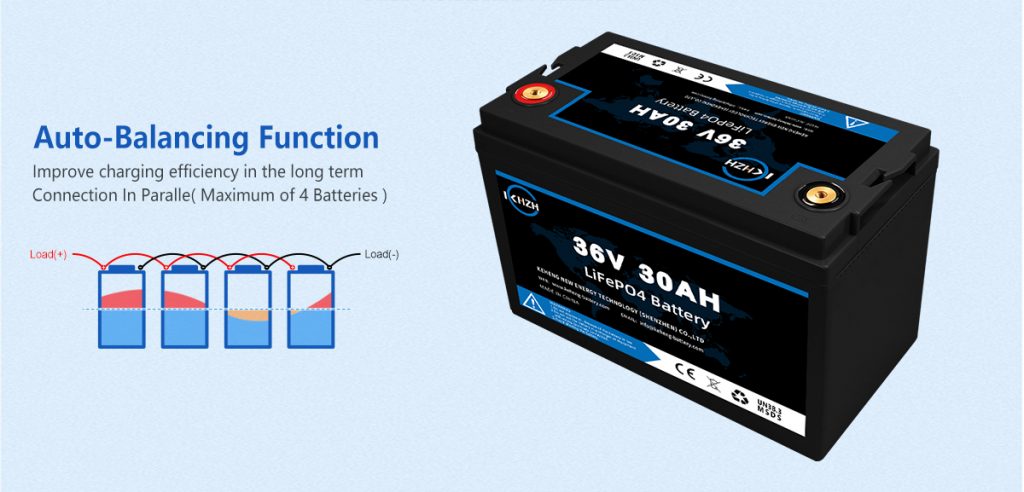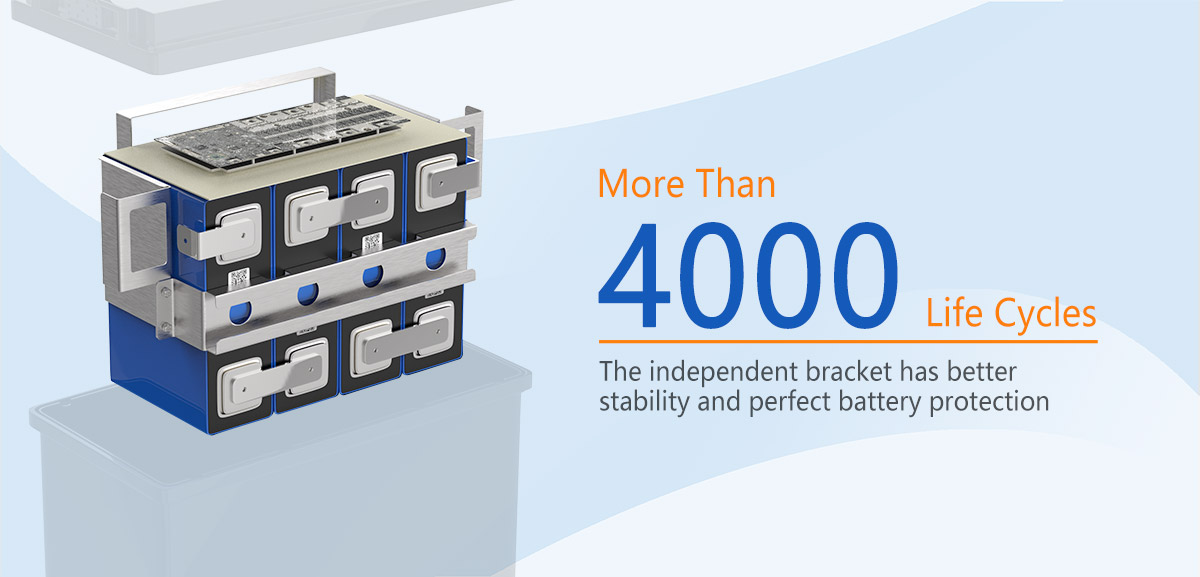Introduction
RV batteries play a vital role in powering the various appliances and systems within an RV, ensuring a comfortable and convenient travel experience for adventurers on the road. These lithium batteries are the lifeblood of an RV, powering vital systems such as lighting, appliances, entertainment devices, and even water pumps and heating/cooling units. Understanding the intricacies of RV batteries is essential for every owner to make informed decisions about maintenance, replacement, and overall power management.

Introduction To RV Batteries
RV batteries come in a variety of types and sizes, usually, RV lithium batteries are 12V lithium batteries, 24V lithium batteries, 36V lithium batteries, and 48V lithium batteries, with 36V lithium batteries being favored by RV owners for their high efficiency and high power output. These deep-cycle batteries provide continuous power for long periods, making them ideal for powering multiple devices in the motorhome at the same time. 36V configurations ensure that there is enough voltage to run high-consumption appliances while maintaining a steady supply of power throughout the journey.

he Importance Of Battery Life In An RV
Understanding the life of a 36V RV battery isn’t just about convenience; it’s also critical to efficiently planning a trip and avoiding unexpected power outages while traveling. By understanding the factors that affect battery life, such as charging habits, frequency of use, and routine maintenance, RV owners can extend the life of their batteries and ensure reliable performance while traveling. With a proper understanding of battery life, owners can also make informed decisions about investing in backup power or upgrading their current battery setup to efficiently meet their energy needs.
Revealing The Nature Of Battery Voltage
Voltage in a battery is a fundamental concept that determines the power capacity and performance of electrical devices, including 36V RV batteries. Simply put, voltage represents the force that drives current through a circuit.
A 36V battery means that it can deliver a constant current of 36 volts to power various systems and appliances in your RV. Understanding this voltage rating is critical for RV owners, as it directly affects the battery’s ability to last a long time without sacrificing efficiency.
Versatile 36V RV Battery Options
Comparison Of Different Types Of 36V RV Batteries
When one is faced with the risk of choosing the most appropriate battery for their RV, weighing the differences between tried and tested lead-acid batteries and the more advanced and lightweight lithium-ion batteries becomes crucial. Widely recognized for their durability and affordability, lead-acid batteries are the traditional first choice for many. However, lithium-ion batteries, despite their higher price, last longer, are lighter, and provide more energy in a smaller package. Understanding the advantages and disadvantages of each battery type is important to make an informed choice based on the specific needs of your RV.
Lead-Acid Vs. Lithium-Ion Batteries
For decades, lead-acid batteries have been the preferred choice of RV owners due to their reliability and affordability. However, the advent of lithium-ion batteries has gained attention for their lightweight layout and longer lifespan. While lead-acid batteries are bulkier, lithium-ion batteries are more compact and can provide more energy in a smaller package. When choosing between these two types of batteries for your RV, it’s crucial to scrutinize the differences in overall performance and price.
Pros And Cons Of Each Battery Type
Lead-acid batteries are known for their resilience and price advantage, making them popular among RV owners. However, lead-acid batteries require regular refurbishment and have a shorter lifespan than lithium-ion batteries. In contrast, lithium-ion batteries are lighter in weight, last longer, and have the lowest maintenance costs. However, they are also more expensive. Knowing the pros and cons of each type of battery will help you figure out which one is best for your RV.

Keheng’s 36V 30Ah lithium battery may be ideal for you. This battery utilizes the latest lithium-ion technology to provide excellent energy density and longevity. It is designed to provide stable power in a variety of environmental conditions, making it an ideal companion for your RV travels.
Factors Affecting 36V RV Lithium Battery Life
The lifespan of a 36V RV battery depends not only on its voltage rating, but also on external factors, frequency of use, and more. In addition, charging habits can have a significant impact on battery life; improper charging techniques such as overcharging or undercharging can lead to premature battery aging. Environmental conditions such as extreme temperatures can also affect battery life; extreme heat or cold can reduce overall battery performance and life. Temperature and weather conditions can also affect the life of a 36V RV battery. Both extreme cold and heat can affect the overall performance and standard life of the battery. It is important to store and use the battery within the recommended temperature range to optimize its life.
Frequency Of Use: Taking Longevity Into Account
When it comes to the service life of a 36V RV battery, frequency of use plays a crucial role. Frequent use of the battery is good for the battery, as it keeps it active and prevents deep discharges that can be harmful. However, over-cycling the battery can lead to premature wear and tear, which can shorten the overall life of the battery.
Occasional use may seem like a way to protect the battery, but it can lead to self-discharge and internal resistance buildup. Therefore, striking a balance between regular and occasional use is the key to maximizing the life of your 36V RV battery.
Regardless of the frequency of use, it is critical to perform proper maintenance routines to extend the life of your 36V RV battery:
1.Inspect and clean the terminals regularly,
2.Inspect for any signs of corrosion or damage
3.Keep the battery ventilated
4.Follow the manufacturer’s guidelines
Charging Practices: The Balancing Act
Charging habits are critical to the life of a 36V RV lithium battery. Overcharging or undercharging can adversely affect the overall health of the battery.
Overcharging causes increased heat generation within the battery cells, which accelerates deterioration and reduces capacity.
Undercharging can lead to a buildup of plate sulfation, reducing efficiency and capacity over time.
Therefore, maximizing the life of your 36V RV battery requires finding the right balance in charging practices.
Implementing the best charging practices is to ensure that 36V RV lithium batteries are charged according to the following principles:
1.use a compatible charger designed specifically for RV batteries to prevent problems such as over-voltage or incorrect charging currents that could damage the battery.
2.following the correct charging protocols, such as avoiding rapid charging or discharging at extreme temperatures, will help to maintain optimum performance and prolong overall life.
Average Of A 36V RV Lithium Battery Life

The average lifespan of a 36V RV battery will be approximately 10-15 years depending on how well maintained and properly used a 36V RV battery is.
However, this estimate can vary greatly depending on the frequency of use, charging habits, maintenance practices, and environmental conditions. A key factor affecting the life of a 36V RV battery is the depth of discharge (DoD) of the battery during use.
A deep discharge is when the battery is consistently near full capacity, which can significantly reduce the life of the battery. Conversely, shallow discharging (using only a fraction of the battery’s capacity at a time) helps to extend the life of the battery.
RV owners can extend the life of their batteries by understanding and managing the amount of battery discharge through proper usage patterns. In addition, the quality and type of 36V RV battery play a critical role in its longevity.
Signs Of Declining Battery Performance
As batteries age and wear out over the life cycle, they will begin to show signs of declining performance levels. Recognizing these early warnings can help RV owners take proactive steps to address potential problems before they escalate into major issues.
A common indicator of declining battery performance is a decrease in capacity or runtime per charge. If you notice that your 36V RV battery is holding less charge than usual or needs to be recharged more frequently, it may be nearing the end of its useful life.
Another sign to look out for is an increase in the self-discharge rate of the battery. Self-discharge is when a battery naturally loses its charge even when not in use.
If you notice that your 36V RV battery loses charge faster when stored or left unused, this could be a sign of internal degradation of the battery structure or aging of the components. In addition, physical changes such as bulging or leaking battery casings are also telltale signs of a 36V RV battery problem.
These telltale signs should never be ignored because if left unaddressed, they can pose a safety hazard or cause irreparable damage. By remaining vigilant and regularly monitoring your battery’s performance for any unusual behavior or symptoms, you can better assess the condition of your battery and plan potential replacement or maintenance accordingly.
Regular Maintenance Tips For A Healthy Battery
Proper maintenance is critical to extending the life of your 36V RV battery. Regularly checking the lithium battery terminals for signs of corrosion and ensuring that they are clean and securely connected is critical; corrosion can hinder battery performance and lead to premature aging.
It’s also a good idea to keep your battery clean from dust, dirt, and other contaminants that can cause short circuits or reduced efficiency.
Cleaning the outside of the battery with a mild solution of baking soda and water will help maintain the condition of the battery. In addition, storing the battery in a dry, ventilated area when not in use prevents the battery from being exposed to temperature or humidity extremes that could degrade the performance of the battery assembly.
Storage And Use Temperature Considerations
The temperature at which a 36V RV battery is stored and used has a significant effect on its service life. Extreme heat or cold can affect the chemical reactions occurring within the battery, which can affect the overall performance of the battery.
It is important to avoid exposing the battery to temperatures above 120°F (49°C) or below freezing whenever possible. In hot weather, shielding the battery from direct sunlight or using insulation will help regulate the battery temperature.
In colder climates, using an insulating blanket or investing in a heated storage solution can prevent the battery from freezing or losing capacity due to low temperatures. By maintaining an optimal operating temperature range for RV batteries, owners can ensure that they run efficiently and last longer.
Conclusion
In delving into 36V RV battery life, we discovered a wealth of essential knowledge for RVers. Understanding the intricacies of battery voltages, the types available, and the key factors that affect service life is essential to ensuring optimal performance and longevity.
Factors such as frequency of use and charging habits play a critical role in the life of a 36V RV battery. Armed with these nuances, RV owners can make informed decisions to extend the life of their batteries.




